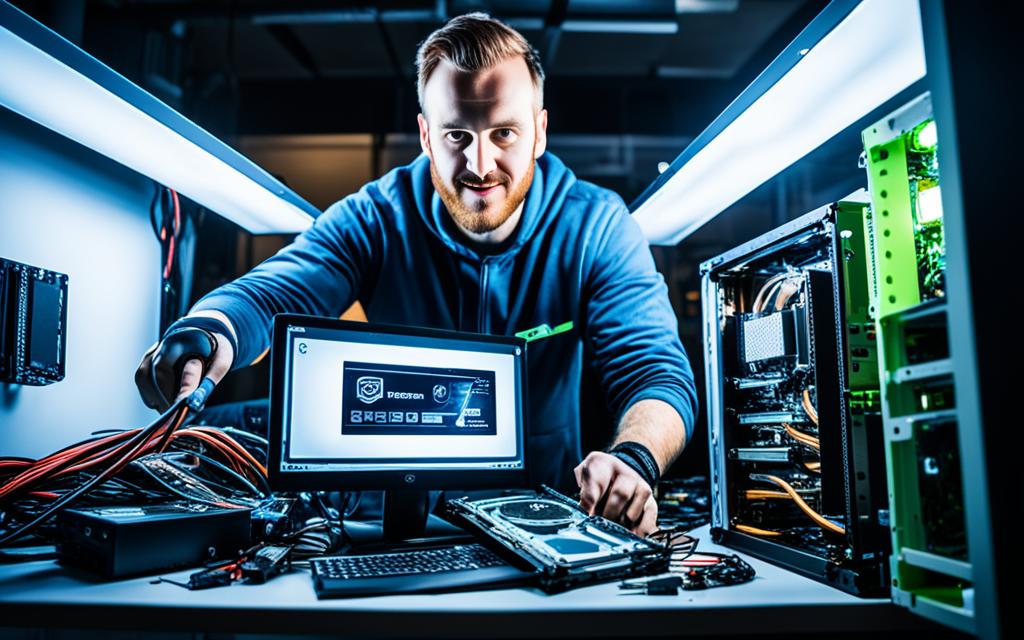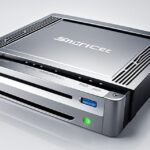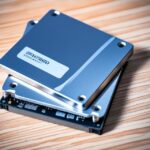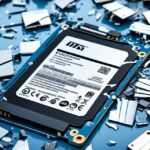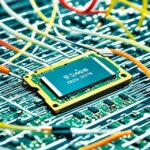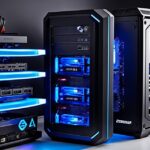Table of Contents
Installing an internal Hard Disk Drive (HDD) boosts your computer’s storage. This is crucial whether you need more space or want to upgrade. Internal drives are reliable and cost-effective, making them a solid choice over external ones which can get lost or damaged. In this guide, we’ll walk through the steps to successfully install an HDD. We’ll cover everything from picking the right drive to finishing setup. It’s important to remember that HDDs are different from Solid State Drives (SSDs), and we’re focusing solely on HDDs. We’ll tackle common questions and make sure you’re ready to enhance your computer’s performance1.
Key Takeaways
- Choosing the right HDD is critical; commonly recommended models include Seagate BarraCuda, Toshiba X300, and WD Black.
- Modern SATA drives typically come in 3.5-inch and 2.5-inch sizes, with 3.5-inch for desktops being the norm.
- Utilising a well-ventilated position for your HDD can prolong its lifespan by ensuring proper cooling.
- Securing the HDD with two screws on each side is a recommended practice for stability during use.
- Verifying the installation through BIOS can help confirm that the drive is operating correctly.
- Ensure that you use the correct SATA cables, as the SATA 3 interface is standard for most modern drives.
Selecting the Right Hard Drive
Choosing the right hard drive means comparing HDD and SSD. HDDs are cheaper and offer more storage. SSDs are faster and best for quick data access. Your choice should match your needs.
Understanding HDD vs. SSD
Speed is key in the HDD vs. SSD debate. SSDs are quicker because they have no moving parts. HDDs need to spin, with speeds between 5400 and 7200 RPM for good performance. For gaming or video editing, consider both speed and storage.
Reliability is also important. SSDs are durable, while HDDs’ reliability varies by make2. Considering both can help ensure you pick a dependable hard drive.
Choosing the Correct Form Factor
The hard drive’s form factor must fit your device. Desktops usually need 3.5-inch HDDs, whereas laptops use 2.5-inch ones2. Matching these sizes is crucial for compatibility.
Gamers often choose an SSD for speed and an HDD for extra space2. Designers might use an SSD for current projects and an HDD for storing completed ones2. It’s about finding the right balance.
| Feature | HDD | SSD |
|---|---|---|
| Speed (RPM) | 5400 – 7200 | Fast (No RPM) |
| Typical Size | 3.5 inch (desktop), 2.5 inch (laptop) | 2.5 inch or M.2 |
| Storage Capacity | Up to several TB | Up to several TB |
| Cost | Lower per TB | Higher per TB |
| Reliability | Depends on MTBF | Higher due to no moving parts |
Consider brand reputation for reliability and customer support. Evaluate your needs carefully. Then, choose between HDD and SSD based on their features34. This approach ensures a wise decision for your tech setup.
Preparing Your Workspace
Getting your space ready for installing a new hard drive is key. A tidy and well-thought-out area boosts safety and work speed. Start by picking up the right tools, such as a Phillips head screwdriver, SATA cables, and HDD mounting screws. This is important if your case doesn’t support tool-free installation. Make sure to clean the area. This prevents your computer parts from getting damaged by dust.
Gathering Required Tools
- Phillips head screwdriver
- SATA cables
- HDD mounting screws (if required)
- Anti-static wrist strap
- Hard drive enclosure/adapter
Ensuring Safety Precautions
Keeping safe while working with hardware is crucial to avoid harming yourself or the parts. It’s important to ground yourself. This stops electrostatic discharge that could ruin delicate components. We suggest wearing an anti-static wrist strap. Or, you can touch a metal surface before you touch any of the internal parts. Make sure your work area is well-lit. It helps you see every connection and piece clearly. This careful planning lessens mistakes and makes the installation smoother.
By following these tips, you make the installation process easier. Taking time to get your workspace ready and sticking to safety rules leads to a successful hard drive setup56.
How to Install HDD
To start installing a new hard drive, first, learn how to open your computer and find the drive bay. The correct steps make this task less daunting, making it easier to upgrade your system.
Opening Your Computer Case
First, get the necessary tools ready, especially a Phillips head screwdriver. Then, carefully unscrew and remove the case’s side panels. Don’t scratch the surface. Once the panels are off, take a moment to look inside before moving on. This step is key to installing your new drive correctly.
Locating the Drive Bay
Next, find the drive bay, crucial for setting up the hard drive. Drive bays are usually at the case’s lower front and come in two types: tool-less or screw-required. Knowing your case layout is important as most desktops hold more than one hard drive7. Learn about your drive connectors, like IDE or SATA, for an easier setup7. If your system has many drives, think about using Storage Spaces to protect data7. Remember, old power supplies might not have SATA connectors, so you may need an adapter8. After finding the right bay, you can secure the new drive and prepare it for connection.
| Drive Type | Installation Procedure | Power Requirements |
|---|---|---|
| PATA (Parallel ATA) | Needs master/slave setup; can be tricky to install. | Comes with standard power connectors. |
| SATA (Serial ATA) | Just connect data and power cables; easier to install. | Each drive should have its own power cable to prevent issues. |
For a detailed guide on installing hard drives or SSDs on Windows and tips for troubleshooting, visit this resource.
Mounting the Hard Drive
Mounting your hard drive correctly is crucial for its performance and longevity. It’s important to use the correct methods when installing it. This ensures a good fit without harming the system.
Screwing in the HDD
For a secure installation, you need four screws, two on each side. This is a common practice that keeps the drive stable and prevents it from moving9. It’s crucial to align the HDD correctly in the bay. A well-secured drive won’t move, protecting it from damage due to other parts’ vibrations.
Using Tool-less Trays When Available
If your system has tool-less drive trays, installation becomes much easier. These trays let you install the HDD quickly without screws, using clips or pins instead. This method not only makes installation quicker but also helps keep good airflow, which stops the HDD from getting too hot10. Using the trays correctly can speed up the installation while keeping everything safe.
Connecting the Hard Drive
The final stage is crucial for linking your hard drive and computer. Knowledge of SATA cable and power supply hookups is key. These steps are vital for your device’s best operation.
Utilising SATA Cables
First, attach the SATA cable’s end to the hard drive, and the other end to the motherboard’s SATA port. The SATA interface needs two key connections: a SATA cable for data and a power cable from the power supply unit (PSU)11. It’s crucial to choose the right SATA channel on the motherboard, usually labeled as SATA0 or SATA1 for the main drive12. Remember, a Serial ATA cable should not exceed 39 inches (1 meter) to keep data moving smoothly11.
Connecting to the Power Supply
Then, it’s time to hook up the power supply to your HDD. Make sure the SATA power cable correctly fits into the hard drive’s notch. This step is less complicated than before since SATA drives don’t need jumper settings11. Ensuring everything is tightly connected is crucial for system reliability. Once done, put the computer case back, connect your equipment, and start the system. Your hard drive is set to go.
Conclusion
Putting in a new HDD is quite easy and boosts your computer’s storage a lot. Just follow the steps from choosing the proper hard drive to connecting it properly13. This whole setup usually only takes between 10-20 minutes for Windows 10 or 11, making it quick and gratifying.
After you’ve installed the new hard drive, make sure to format it. This step ensures it’s ready to store your data. Hard drives larger than 1TB offer loads of space for your files and programs14. Through careful preparation and focus, you can better your computer’s function and increase your storage space.
If you’re keen on getting more into it, tools like EaseUS Partition Master help with starting and splitting your new hard drive the right way. They make sure you pick the best partition style for your system. For a full run-down on assembling your PC, have a look at this detailed guide. It’s great for both tech fans and newbies.
FAQ
What tools do I need to install an internal hard drive?
You’ll need a Phillips head screwdriver, SATA cables, and mounting screws for your HDD. Make sure your workspace is clean for a smooth installation process.
How do I choose the right hard drive for my computer?
Think about HDDs versus SSDs. HDDs give you more storage for your money, perfect for saving lots of files. Make sure the hard drive’s size fits your computer, like 3.5-inch for desktops and 2.5-inch for laptops.
What safety precautions should I take during HDD installation?
To keep safe, ground yourself to avoid static damage. Use an anti-static strap or touch metal. Ensure your work area is well-lit and tidy, to protect delicate parts.
How do I open my computer case for the installation?
Use a Phillips head screwdriver to take off the side panels. This lets you get to the inside, where you can find the hard drive bays at the front lower part.
How do I mount the HDD securely?
Fix the HDD in place with four screws, two on each side. Or if you have a tool-less case, use clips or pins to avoid rattles or damage later on.
How do I connect the HDD to my motherboard?
Connect one end of the SATA cable to the HDD and the other to a motherboard slot. Then, connect the power cable from the PSU ensuring they fit properly.
What should I do after installing the HDD?
Once you’ve installed it, put the computer’s case back on and plug in your devices. Turn on your computer and set up the new drive from your operating system for storing data.
Source Links
- https://www.pcworld.com/article/535852/how-to-install-a-new-hard-drive-in-your-desktop-pc.html – How to install a hard drive in your computer
- https://trinware.com/hardware/choosing-the-right-hard-drives/ – How to Choose the Right Hard Drive: Your Essential Buying Guide – TrinWare
- https://www.reddit.com/r/buildapc/comments/908f0n/guide_for_adding_a_storage_drive_to_your_pc_for/ – Reddit – Dive into anything
- https://www.easeus.com/partition-master/install-a-new-hard-drive-or-ssd.html – Beginner’s Guide – Install A New Hard Drive/SSD in Windows 10/8/7
- https://www.linkedin.com/advice/1/what-steps-install-new-hard-drive-computer-edjcc – What are the steps to install a new hard drive in a computer?
- https://superuser.com/questions/1372730/how-can-i-connect-a-desktop-hard-drive-to-my-computer-via-usb – How can I connect a desktop hard drive to my computer via USB?
- https://www.dummies.com/article/technology/computers/operating-systems/windows/windows-10/how-to-install-a-second-internal-hard-drive-on-your-windows-10-device-255316/ – How to Install a Second Internal Hard Drive on Your Windows 10 Device
- https://www.ifixit.com/Wiki/Installing_a_Hard_Drive – Installing a Hard Drive
- https://www.helpwithpcs.com/upgrading/install-hard-drive.htm – How to install a hard drive
- https://downloads.checkpoint.com/dc/download.htm?ID=32420 – Installation Guide
- https://www.seagate.com/support/kb/how-to-install-and-troubleshoot-serial-ata-sata-hard-drives-196169en/ – How To Install and Troubleshoot Serial ATA (SATA) Hard Drives | Support Seagate US
- https://www.computerhope.com/issues/ch000413.htm – How to Install a Hard Drive or SSD
- https://www.easeus.com/partition-manager-software/install-a-new-hard-drive-on-windows-11.html – Tutorial: Install a New Hard Drive on Windows 11 Safely
- https://innocentric.gr/how-to-install-a-new-hard-drive-to-replace-an-old-one/ – How To Install A New Hard Drive To Replace An Old One – INNOCENTRIC IT Systems- Computing and Services

